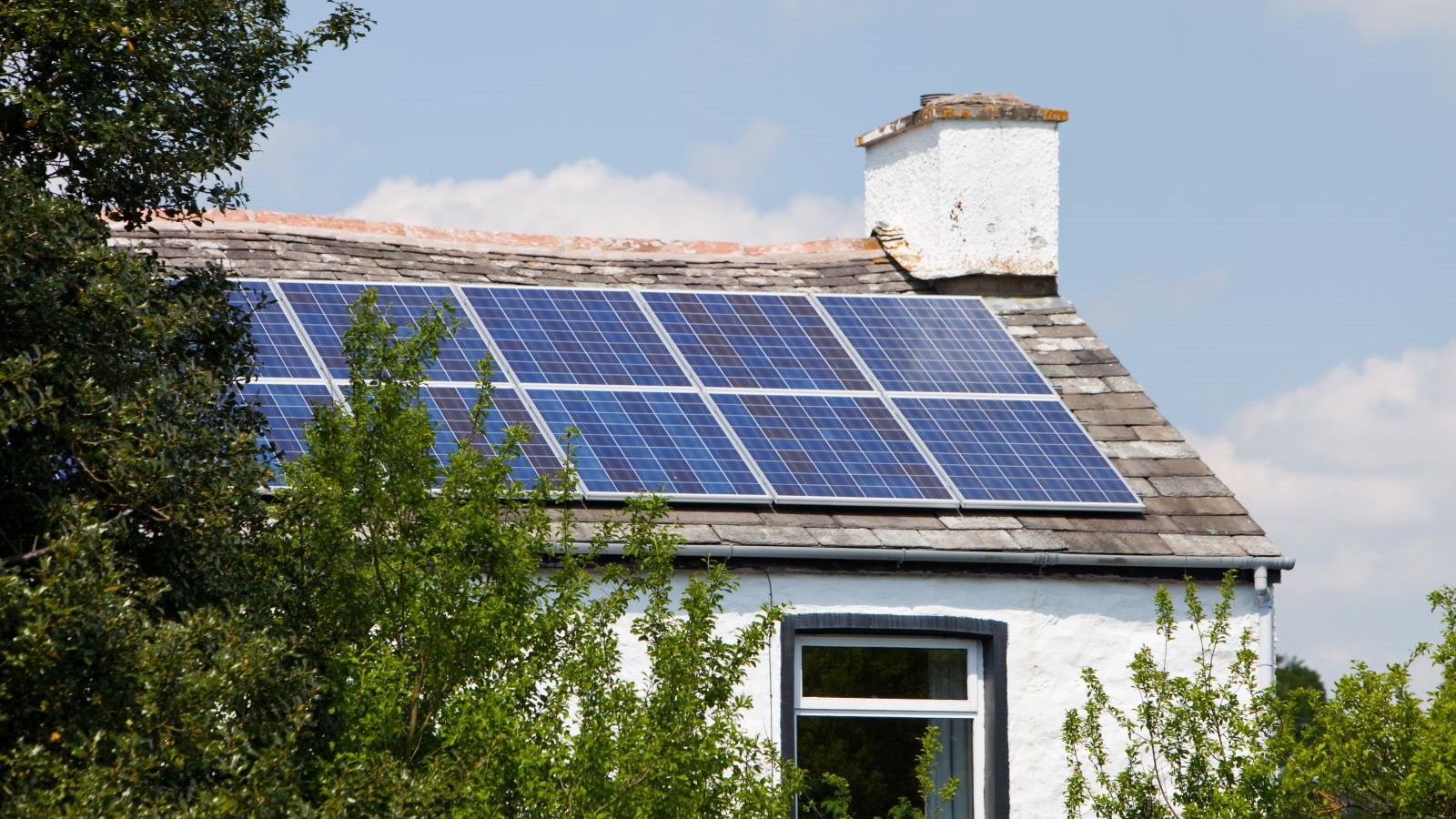Here's what you really need to know about installing solar panels in conservation areas
Our building expert explains everything you need to consider if your home is in a conservation area and you are hoping to install solar panels

Living in a conservation area used to mean grappling with strict rules that could make updating your property a challenge, especially when it came to installing renewable technologies like solar panels.
However, with the growing need for renewable energy, regulations around installing solar panels in conservation areas are becoming more flexible making it more feasible to incorporate solar panels into historically significant areas.
This article explains the key considerations when planning solar panel installations in areas of high architectural value such as conservation areas.
Finding out if you live in a conservation area
Conservation areas are controlled by planning regulations that affect things like the type of windows you can install, the materials you can use, or improvements that can be made. Installations such as solar panels are therefore controlled and unless it can be proven that the installation will not cause harm, restrictions may be imposed.
The main types of conservation area – and what this means in terms of whether or not you can install solar panels – include:
1. Urban conservation areas: These include historic town centres and suburbs where visual impact is important. Any changes to a property, including installing solar panels, will be closely scrutinised.
2. Rural or village conservation areas: These areas cover villages or rural settings with historical significance where preserving the visual integrity of the area is essential.
Bring your dream home to life with expert advice, how to guides and design inspiration. Sign up for our newsletter and get two free tickets to a Homebuilding & Renovating Show near you.
3. Landscape or scenic conservation areas: These focus on preserving natural beauty and might include historic buildings. Solar panel installations may be more restricted if they disrupt the scenic value.
To find out if you live in a conservation area, contact the local planning authority who will confirm whether your property is within a designated area. Alternatively, visit the local planning authority’s website and have a look at the maps under the planning section. These will usually identify the designation of specific areas such as conservation areas
Challenges of installing solar panels in conservation areas
Solar panels are beneficial as they offer a degree of energy independence by not having to rely on power from the national grid. As a renewable technology they’ll lower energy costs whilst reducing your carbon footprint.
Solar panels and especially solar PV (photovoltaics) also play an important role as a partner technology to power other renewable tech, like heat pumps and electric vehicle (EV) chargers, which are rapidly growing in popularity.
Whilst solar panels have obvious benefits, there are a few challenges to consider when installing solar panels in a conservation area. Firstly, aesthetic concerns. Conservation areas are designated to protect their historical and architectural significance. Any changes to properties within these areas, including the installation of solar panels, are regulated to ensure that they do not negatively impact the area's character.
Poorly integrated solar panels can detract from the historic or architectural value so expect a few regulatory hurdles and restrictions which might affect where and how solar panels can be installed, which could limit their effectiveness.
The government is working to ease restrictions on solar panel installations, even in conservation areas, as part of its broader efforts to promote renewable energy. Future legislation is expected to introduce new standards for solar panels and could relax some of the current restrictions in conservation areas.
Are solar panels allowed in conservation areas?
Solar panels can be installed in conservation areas, but with stricter rules than in non-conservation areas.
The National Planning Policy Framework (NPPF) highlights the importance of both heritage conservation and environmental sustainability. However, the NPPF does not prioritise one over the other and seeks to balance the two whilst promoting the transition to a low-carbon future.
For solar panel installations within conservation areas, the NPPF recommends careful design to minimise harm to heritage assets. This means the scale, type, and location of solar panels should be chosen to complement the historic significance of the building and the area. As such, the following guidance should be followed.
1. Aesthetic considerations: In conservation areas, where preserving the visual character is a priority, solar panels should be installed in a way that minimises their visual impact. This typically means:
- Placing them on less visible parts of the building, such as rear-facing roofs.
- Avoiding installation on front elevations or roofs visible from public roads or footpaths.
- Ensuring that the panels do not project above the ridge line of the roof.
2. Proximity to listed buildings or scheduled monuments: If the property is a listed building or in the vicinity of one, there are additional restrictions and special permission for solar panels on listed buildings such as Listed Building Consent may be required.
3. Materials and design: The design, materials, and colour of the solar panels should be chosen to complement the existing building and the conservation area. For example, black-framed panels or non-reflective coatings might be required.
4. Impact on the historic fabric: The installation should not damage or remove any historic features of the building, such as traditional roof tiles, chimneys, or architectural details.
The local authority will consider not just the individual impact of the solar panels on the specific building but also the cumulative effect if multiple properties in the area were to install solar panels.
The aim is to avoid a situation where the overall character of the conservation area is gradually eroded by multiple modern installations. In some cases, the local authority may suggest alternative renewable energy solutions that are less visually intrusive, such as solar slates or ground source heat pumps.
Can solar panels in conservation areas be installed under PD rights?
Unlike in non-conservation areas, where solar panel installations may be allowed under Permitted Development Rights, most installations in conservation areas require full planning permission for solar panels. This means you must submit an application that will be evaluated on its potential impact on the area's character.
However, regulations can vary depending on the location and the local planning authority (LPA). It's therefore always advisable to check with the LPA and consult with local conservation officers to understand whether there are any specific rules or restrictions.
For solar panel installations in conservation areas to fall under permitted development, the conditions relating to the roofline and projection limits must be met. Panels should not extend above the roof’s slope or ridgeline and should project no more than 200mm from the roof or wall surface.
In some cases, conservation areas have an Article 4 direction in place, which removes permitted development rights for work that affects the elevations fronting a public highway. This means that planning permission is needed for solar panel installations that fall foul of the criteria.
Do I need building regulations?
Even if planning permission isn't required, solar panel installations must still comply with building regulations to ensure that installations are safe, structurally sound, and energy efficient. The key points to consider are:
1. Structural safety: The roof must be able to support the additional weight of the solar panels. This is especially important for older buildings common in conservation areas.
2. Electrical safety: The installation must comply with Part P of the building regulations, covering electrical safety. Certified electricians should carry out the installation and self-certify compliance.
3. Thermal performance: If the installation affects the building’s insulation, alterations to the building fabric must comply with Part L of the Building Regulations.
Depending on the extent of work involved, most installations can be self-certified by a competent person under the Microgeneration Certification Scheme (MCS).
This simplifies the process, as approval from your local authority's building control department is not needed. If structural alterations are necessary, the best approach is to submit a building notice to the building control department who will inspect the work and check that everything is in order.
Installing solar panels in a conservation area is not only possible but increasingly common as the need for renewable energy grows.
Unless the building is listed, by carefully planning the installation and adhering to any specific planning restrictions to preserve the unique character of your conservation area, there is no reason why most homes with a conservation cannot support a solar panel installation.
Mark Stevenson has worked as a construction professional for over 30 years and following an extensive career in housebuilding. He is currently chief operating officer for Custom Build Homes and chair of the National Custom and Self Build Association. He previously worked as managing director for Potton, helping self builders build their own homes.
Whilst Mark describes himself as a ‘professional builder’ as a result of his career in housebuilding and timber building system manufacturing, he has specialist knowledge of timber construction and extensive expertise in finding land and project management.
He regularly shares his knowledge at Homebuilding & Renovating Shows and and coaches self builders about how to build their own homes. Aside from Mark’s professional career, his skills also extend to practical building knowledge as a skilled joiner, hands-on renovator and serial self-builder of his own development projects.
He is also Vice Chair of industry body, the Structural Timber Association.

